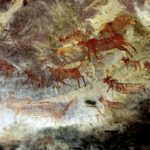Basics
- The prehistoric paintings were generally executed on rocks and these rock engravings were called Petroglyphs.
- One of the key examples of prehistoric paintings in India is in Bhimbetka caves in Madhya Pradesh.
Phases
| Phases | Features |
| Upper Paleolithic Period (40,000-10,000 BCE) |
|
| Mesolithic Period (10,000-4000 BCE) |
|
| Chalcolithic Period |
|
Bhimbetka Rock Paintings
|

